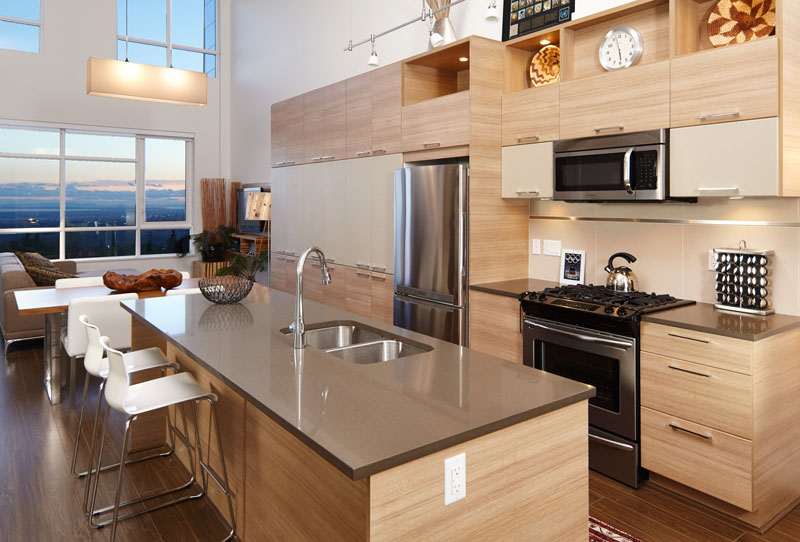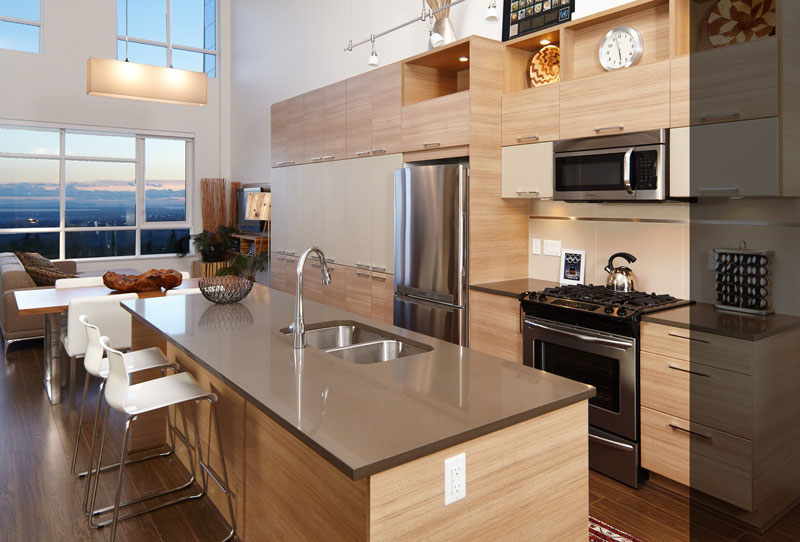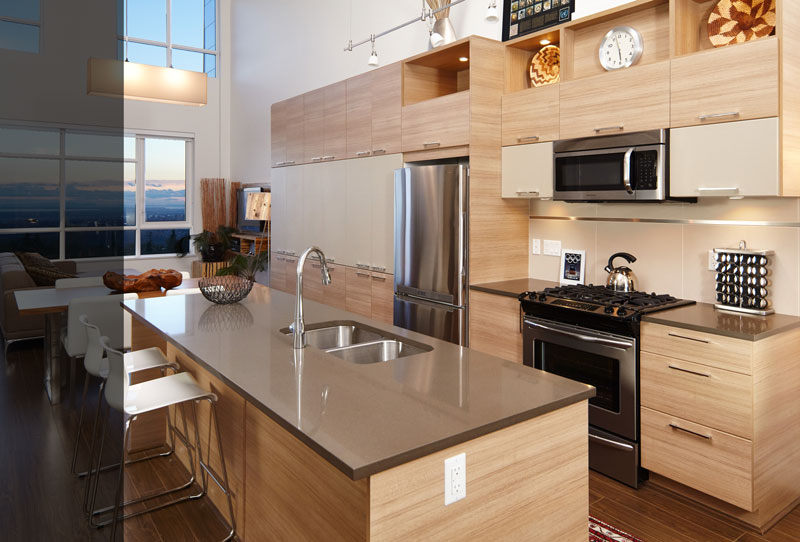We're a sponsor (and a big fan) of the GVHBA Ovation Awards for Metro Vancouver-area residential projects, and this year's call for entries went out a couple of weeks ago. Hidden in the large pile of paper (or lengthy PDFs, if you're flipping through online) that makes up the call for entries are a number of photo-related goodies and things to be aware of. If you're like most people, you zipped right by the photo specs on the way to seeing which of your projects might qualify and in what categories. As an architectural photographer, I of course perused the photo specs first, and noticed that they've made a bunch of solid changes this year that will affect how you prepare your entries and give you a lot of room for showing your project better and more creatively. Here's a rundown of what to be aware of, and what the consequences are:
- File size rather than image size requirement. In past years, you've needed to submit images with a particular image size and resolution (it's been 2400x3000 for the last couple of years running). This year, they've dropped this in favour of a file size requirement of 5 megabytes. This is easy to check for: pull up the Finder (if you're on a Mac) or Windows Explorer (on Windows) and check to make sure that all .jpg files you submit are less than 5MB apiece. Notably, there is no minimum size, but we would suggest targeting something in the 2400x3000 range as that will generate a good 8x10 print at 300dpi. How you do this, and what you size to, can get complex, and it has a number of implications for how you submit. More on that in just a bit.
- Any aspect ratio goes. Since there is no image size requirement, any good printable-at-a-reasonable-size-at-300dpi image will work at any aspect ratio. This means that if you have a 'widescreen' view of your project, you could now submit this, where you haven't been able to in the past. It also means that we don't have to crop your images to a particular size, and can compose at whatever aspect ratio as will show off your project the best. Having said that, as long as the Georgies and the SAM Awards require fixed image sizes, we'll probably still compose most of your images to fit an 8x10 print without much/any cropping. There are a number of places where going wider, taller, or square will help tell your project's story and possibly save you having to submit an extra image to show some detail that would show up on the edge of an image but have to be cropped otherwise. For example, this year you could submit an image like this:

...whereas in past years, you'd be forced into a crop that would either emphasize the living room, or most of the kitchen, but not show how both relate:


- You now have a "choice" photo. Some of you have likely had the experience of sitting at the Ovation Awards gala, having your finalist project come up on the screen, and wondering "why for the love of all things good and holy did the judges choose that shot when this shot was clearly better!?" (Then you got your award, had a celebratory beverage, and forgot all about it except for that little lingering bit of "what was I on about?" the next day.) The GVHBA heard us all: you can now indicate what image is your choice for marketing purposes. Think carefully about this: the choice photo is probably going to be the one that tells the best story about your project in one photo. On the flip side, it might be the 'coolest' shot of the lot--maybe it's your twilight exterior if you're submitting in a category that will let you submit one.
- Video is permitted, but only in the Technical Innovation category (39). Category 39, better known by the mouthful Excellence in Technological Innovation in Residential Construction, is very cool. As chair of the GVHBA Suppliers' Council, I am pleased to point out that it's the only category where suppliers can enter as the primary entrant (provided you get a GVHBA builder/renovator to sign on with you as primary associate). It's also the only category where video is permitted. Let's say you're submitting a project that includes a fold-out corner cabinet design. You can and should show how this works in several photos, but the full impact might be better shown by a 15-second video, particularly if the thing you're submitting is innovative in its assembly or other not-obvious-in-a-still-photo way. We're happy to shoot and edit that little piece of video for you, for an extra charge (and about an extra half hour on site)--just let us know that you're entering this category and we'll talk it through.
What does all that file size gibberish mean?
If you have photos already that you might be considering submitting, you might have just checked them and found either that they're a lot bigger than 5MB, or a lot smaller. What to do?
- You have images that are way bigger than 5MB. Earlier in this article, I advised you to target a resolution that's around 2400x3000. If you're looking at the full resolution images we provide you, you'll probably find that they're often around 7000x5000 and tip the scales at 10-15MB. You have three options: 1. downscale them to something that will fit under the 5MB bar, 2. crop them down to something that will fit, or 3. dial down your JPEG quality settings and re-save until the image fits. Of these, we'd recommend one of the first two options. If you want to show everything in the image, then by all means downscale them--you'll preserve the composition of the image, and a lot of the detail. (It might actually enhance some of the detail depending on how you do it). If you have a large image where the important part to your story is a lot smaller, cropping the stuff you don't want to show is a good way to start--particularly because you don't have to crop to a particular aspect ratio, so you can take a nice tight crop that just shows what you want. We do not recommend taking option 3 because that gives you the worst of both worlds: you lose a bunch of your image detail, and you have a big image that makes the judges' life more difficult for no good reason.
- You have images that are way smaller than 5MB. Check the image resolution. If they're around 2400x3000 or larger, you are good to go. As an aside, it's entirely likely that you may run into an image that's a lot larger than 2400x3000 but is still well under 5MB, and that's OK. JPEG files use "lossy" compression, which means that large areas of your image that are close to the same colour, like white drywall and clear blue skies, compress well whereas detailed areas like grass and fabric occupy more space. If your image is much smaller than 2400x3000 (for instance, you're considering re-submitting your Georgie images for the Ovations), you're technically fine, but it's not ideal because you could be submitting a larger image with more detail, and the judges might zoom in on an area and wish to see something that isn't there but would be in a larger image. So if you have a larger version of your image, why not take advantage of the extra file size and show more of the fine detail that often sets your project apart from the pack? Do not upsample your small image to make it larger--this will introduce noise and artifacts needlessly. You're better off submitting a clear lower resolution image than a fuzzy higher resolution image, but a clear higher resolution image (which you can likely get from your photographer, or from resizing a higher resolution image) is the best.
Also, requiring 5MB images will mean that if you're on a slow connection, your images will take a few minutes to upload. And so will everyone else's, which is going to put a bit of load on the submission servers if you're hitting the last minute before the deadline. Yet another reason to enter early if you can.
Wow...this is stinkin' complex. Can I just call you and get it all taken care of?
Yes, you can! In fact, we'd recommend it. If you have full resolution images in your files already, we can take care of all this and size them so that you get the most from your images while still fitting in the submission requirements, for a nominal fee. If we made the photos that you're going to submit, we include image prep as part of our awards packages, so you can call us up and not worry about it. We're happy to take care of it all for you, since we practically live and breathe this stuff. And if you're going to submit a project and haven't had us photograph it yet, what are you waiting for?
